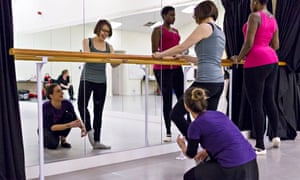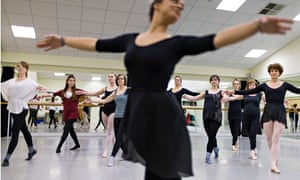Taken to see The Nutcracker aged five, I disgraced myself by standing up in the auditorium and shouting “I want to be a fairy too!” Sadly, I was devoid of talent and quit ballet lessons that year, but the fantasy remained. More than 30 years later, I assumed I was too old to try again, so it is a happy surprise to discover that you can learn ballet at any age – even after most professional dancers have long since retired.
Attending a beginners’ class for adults at Brighton Ballet School, I discover that thwarted childhood ambition is a common theme. Until last year, Diane Braid, 51, a physical therapist, had never done ballet. After her children left home, she looked for new ways to occupy herself, and is now “obsessed”.
Diane tells me she was surprised to find that ballet is also a great way to meet new people. That morning, she picked up her kit with her fellow student Beth Jones, 32, and they are identically attired in chiffon skirt, tights, and leotard. “It’s turned out to be very sociable,” says Diane. “I live 10 miles away – I didn’t want to do it with anyone I knew. But Beth and I have become friends.”

The atmosphere is relaxed, yet the class is keenly focused. The school’s principal, Sonya Pettigrew, says: “A common childhood ballet memory is feeling like an elephant, clumsy and unable to keep up. At that point, most people give up.
“But it’s creative, expressive, great for flexibility and co-ordination. And even adults with no experience can achieve amazing things. They come in and fall over their own feet, but by the time they leave, their wellbeing has improved, they look more poised, and they stand an inch taller.”
Sonya, 5’11”, could, one suspects, whip anyone into shape. When one student executes an imperfect plié, she barks: “It’s like you’re sitting on the toilet! Tail under. Flat back. I don’t want to see anyone sitting on a motorbike.”
We work at the barre, and the teacher, Lindsay George, forcibly bends my foot into the desired crescent and tells me: “You’ve got a lot of turnout if you choose to use it.” In layman’s terms that means I can rotate my leg from the hip, causing my knee and foot to turn out, which is a good thing. I am overjoyed: I have potential. I force my leg straight, back and out. It’s agony.
Sonya praises our battement tendu (leg extended, toes on floor, heel off, and stretching instep, sweeping round) – “It’s meant to hurt – embrace the pain” – but takes issue with our dreary expressions: “You look like you’re waiting at a bus stop.” She calls on Lindsay to demonstrate her “ballet face”. Lindsay instantly composes her features into the serene snootiness of every dancer in every corps de ballet. We are told to go home and practise in front of the mirror.

This is a grade 1 vocational class, and the training gives you the basic skills required to progress, though Lindsay notes that some students there have reached grades 5 and 6 – “heading towards a professional level” – and one graduate has joined a contemporary dance troupe. I can see that these women, of every age and size, are not only competent: they’re graceful.
Sadly, I have a way to go. For our finale, we leap and bound in perfect synchronicity across the room. Everyone else patters. I thump and jump like a small child playing hopscotch. Afterwards, body parts that are accustomed to slouching ache in protest. I feel I’ve been stretched on the rack. But although I have previously suffered from a bad lower back, Sonya’s correction is so precise that it’s miraculously unharmed. And although every other muscle hurts, it is in a way that is gratifying, rather than crippling.
Days later, I find myself singing a few bars of Prokofiev’s Romeo and Juliet and tiptoeing stiffly around the kitchen as if en pointe. A part in the Nutcracker might be out of reach, but I’m considering another trip to the barre.
Brighton Ballet School, 07595 303 180; brightonballetschool.co.uk
Source: Read Full Article
